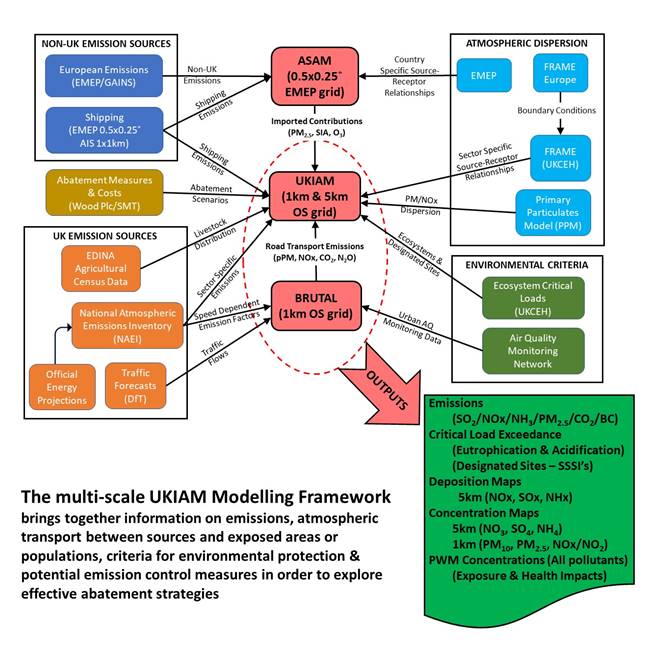National and urban scale modelling: the UKIAM model

The UK Integrated Assessment Model (UKIAM) has been developed to investigate emissions control strategies in the UK that are cost-effective in maximizing improvement in protection of the environment while helping to comply with the UK's international commitments on national emission ceilings and air quality legislation. Protection of the environment includes human health with respect to human exposure and air quality standards, and protection of natural ecosystems through reducing exceedance of critical loads as the maximum annual deposition sustainable to avoid adverse effects. It brings together UK data based on the work of other DEFRA contractors, with emissions data based on the National Atmospheric Emissions Inventory, source apportionment reflecting the response of concentrations and deposition to changes in UK emissions based on the FRAME model of UKCEH, and information on abatement measures on SO2, NOx and primary PM2.5 from other government contractors and from Rothamsted and ADAS for NH3 from agriculture as the main NH3 source. The model can then be used in scenario analysis mode to examine the effect of selected measures, or in optimization mode selecting measures in order of cost effectiveness in moving towards targets for environmental protection.
At the urban scale UKIAM has been modified to model NO2 and Particulate Matter (PM10 & PM2.5), particularly in London and other major cities, using a finer grid resolution and with the road network superimposed - see modelling of the transport sector and the BRUTAL model. This work has focussed on the effectiveness of both technical measures aimed at reducing exhaust emissions, and non-technical measures such as congestion charging that reduce traffic volumes and thus also emissions from brakes, tyres and road abrasion as well as exhausts.
In recent work UKIAM has been extended to consider greenhouse gases as well as air quality pollutants, and investigate synergies in combined strategies for control. This development parallels corresponding developments in European scale modelling by IIASA for the European Commission with the GAINS model, and involves extending the range of measures considered to include, for example, changes in energy generation as well as add-on or "end-of-pipe" measures to control specific pollutants.
Instead of cost-curves for individual pollutants, each measure is associated with corresponding effects on the whole range of pollutants and greenhouse gas emissions from the sources affected, with only a single associated cost. This will enable us to study the environmental and economic advantages of an integrated approach to air quality issues and climate change.
UKIAM Publications
- Oxley, T., Vieno, M., Woodward, H., ApSimon, H., Mehlig, D., Beck, R., Nemitz, E., & Reis, S., 2023, Reduced-form and complex ACTM modelling for air quality policy development: A model inter-comparison, Environment International, 171 (2023) 107676, https://doi.org/10.1016/j.envint.2022.107676
- ApSimon, H.; Oxley, T.; Woodward, H.; Mehlig, D.; Holland, M.; Reeves, S., 2023, Integrated Assessment Modelling of Future Air Quality in the UK to 2050 and Synergies with Net-Zero Strategies. Atmosphere 2023, 14, 525. https://doi.org/10.3390/atmos14030525
- ApSimon, H., Oxley, T., Woodward, H., Mehlig, D., Dore, A. & Holland, M., 2021, The UK Integrated Assessment Model for source apportionment and air pollution policy applications to PM2.5, Environment International, EI_106515, https://doi.org/10.1016/j.envint.2021.106515
- Oxley, T., ApSimon, H. & A. de Nazelle, 2015, Investigating potential health benefits of focussed PM2.5 emission abatement strategies in London, Environmental Modelling & Software, 74, pp 268-283, https://doi.org/10.1016/j.envsoft.2015.07.011
- Oxley, T., Dore, A., ApSimon, H., Hall, J. & Kryza, M., 2013, Modelling future impacts of air pollution using the multi-scale UK Integrated Assessment Model (UKIAM), Environment International, 61, pp 17-35, https://doi.org/10.1016/j.envint.2013.09.0
- Oxley, T., ApSimon, H., Valiantis, M., 2011, Modelling national air quality strategy scenarios with UKIAM: uncertainties emerging from the integration of multiple spatial scales, International Journal of Environment and Pollution, 2011, Vol:44, Pages:54-61, ISSN:0957-4352, http://doi.org/10.1504/IJEP.2011.038402
- Oxley, T. & ApSimon, H., 2007, Space, time and nesting Integrated Assessment Models, Environmental Modelling & Software, 2007, Vol:22, Pages: 1732-1749, https://doi.org/10.1016/j.envsoft.2007.02.002
- Oxley, T. , ApSimon, H., Dore, A., et al, 2003, The UK Integrated Assessment Model (UKIAM): A national scale approach to the analysis of strategies for abatement of atmospheric pollutants under the Convention on Long-Range Transboundary Air Pollution, Integrated Assessment, 2003, Vol:4, Pages:236-249, https://doi.org/10.1080/1389517049051538
Reports to Defra
ApSimon, H., Oxley, T., Woodward, H., Mehlig, D., Holland, M., Vieno, M., Rowe, E., Dragosits, U., & Reis, S., 2022, Analysis of abatement options to reduce PM2.5 concentrations, Report to Defra under contract ECM-53210, Support for National Air Pollution Control Strategies (SNAPCS), https://uk-air.defra.gov.uk/library/reports?report_id=1105 .
For staff
If you are a new CEP staff member and would like to be included on the research webpages, or would like to amend your existing details, please submit this form (login required- only works for members of CEP).